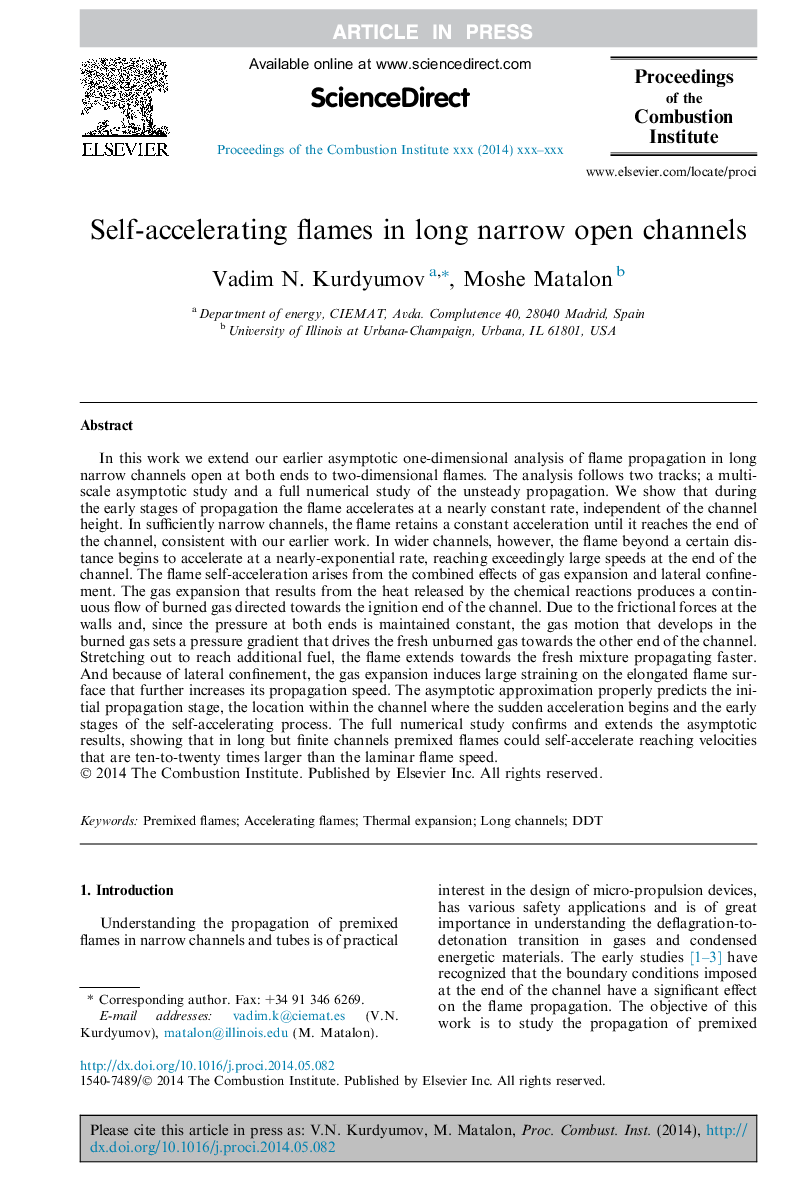| کد مقاله | کد نشریه | سال انتشار | مقاله انگلیسی | نسخه تمام متن |
|---|---|---|---|---|
| 6679383 | 1427921 | 2015 | 8 صفحه PDF | دانلود رایگان |
عنوان انگلیسی مقاله ISI
Self-accelerating flames in long narrow open channels
ترجمه فارسی عنوان
شعله های خود شتاب دهنده در کانال های باز و بلند باریک
دانلود مقاله + سفارش ترجمه
دانلود مقاله ISI انگلیسی
رایگان برای ایرانیان
کلمات کلیدی
ترجمه چکیده
در این کار، ما تجزیه و تحلیل یک بعدی یک بعدی یک شعله را در کانال های کوچکی که در دو طرف به شعله های دو بعدی باز می کنیم، گسترش می دهیم. تجزیه و تحلیل به دنبال دو آهنگ؛ یک مطالعۀ تکاملی چند مقیاس و مطالعه کامل عددی از انتشار ناپایدار. ما نشان می دهیم که در مراحل اولیه انتشار شعله در سرعت تقریبا ثابت، بدون افزایش ارتفاع کانال، تسریع می شود. در کانال های باریک باریک، شعله تا زمانی که به انتهای کانال برسد، مطابق با کار قبلی ما، شتاب ثابت را حفظ می کند. با این حال، در کانال های وسیع تر، شعله ای که فراتر از یک فاصله معین است، شروع به سرعت در سرعت تقریبا شفاف می کند و به سرعت بسیار زیاد در انتهای کانال می رسد. خود شتاب شعله ناشی از اثر ترکیبی گسترش گاز و محوطه جانبی است. گسترش گاز که ناشی از گرمای آزاد شده توسط واکنش های شیمیایی است، جریان دائمی گاز سوزانده شده را به سمت انتهای اشتعال کانال هدایت می کند. با توجه به نیروهای اصطکاکی در دیواره ها، و از آنجا که فشار در هر دو طرف به طور ثابت نگه داشته می شود، حرکت گاز که در گاز سوخته ایجاد می شود، یک گرادیان فشار ایجاد می کند که گاز ناپدید تازه را به سوی انتهای دیگر کانال هدایت می کند. کشش برای رسیدن به سوخت اضافی، شعله گسترش می یابد نسبت به مخلوط تازه گسترش سریع تر. و به علت محصور شدن جانبی، گسترش گاز موجب فشار زیادی بر سطح شعله بلند می شود که سرعت انتشار آن را افزایش می دهد. تقریب تقریبی به درستی پیش بینی مرحله اولیه انتشار، محل در کانال جایی که شتاب ناگهانی شروع می شود و مراحل اولیه فرآیند خود شتاب دهنده. مطالعه عددی کامل نتایج را تایید و گسترش می دهد و نشان می دهد که در کانال های طولانی اما محدود کانال های پیش تصحیح شده می تواند سرعت خود را افزایش دهند که سرعت ده تا بیست برابر بزرگتر از سرعت شعله لامینار است.
موضوعات مرتبط
مهندسی و علوم پایه
مهندسی شیمی
مهندسی شیمی (عمومی)
چکیده انگلیسی
In this work we extend our earlier asymptotic one-dimensional analysis of flame propagation in long narrow channels open at both ends to two-dimensional flames. The analysis follows two tracks; a multi-scale asymptotic study and a full numerical study of the unsteady propagation. We show that during the early stages of propagation the flame accelerates at a nearly constant rate, independent of the channel height. In sufficiently narrow channels, the flame retains a constant acceleration until it reaches the end of the channel, consistent with our earlier work. In wider channels, however, the flame beyond a certain distance begins to accelerate at a nearly-exponential rate, reaching exceedingly large speeds at the end of the channel. The flame self-acceleration arises from the combined effects of gas expansion and lateral confinement. The gas expansion that results from the heat released by the chemical reactions produces a continuous flow of burned gas directed towards the ignition end of the channel. Due to the frictional forces at the walls and, since the pressure at both ends is maintained constant, the gas motion that develops in the burned gas sets a pressure gradient that drives the fresh unburned gas towards the other end of the channel. Stretching out to reach additional fuel, the flame extends towards the fresh mixture propagating faster. And because of lateral confinement, the gas expansion induces large straining on the elongated flame surface that further increases its propagation speed. The asymptotic approximation properly predicts the initial propagation stage, the location within the channel where the sudden acceleration begins and the early stages of the self-accelerating process. The full numerical study confirms and extends the asymptotic results, showing that in long but finite channels premixed flames could self-accelerate reaching velocities that are ten-to-twenty times larger than the laminar flame speed.
ناشر
Database: Elsevier - ScienceDirect (ساینس دایرکت)
Journal: Proceedings of the Combustion Institute - Volume 35, Issue 1, 2015, Pages 921-928
Journal: Proceedings of the Combustion Institute - Volume 35, Issue 1, 2015, Pages 921-928
نویسندگان
Vadim N. Kurdyumov, Moshe Matalon,
